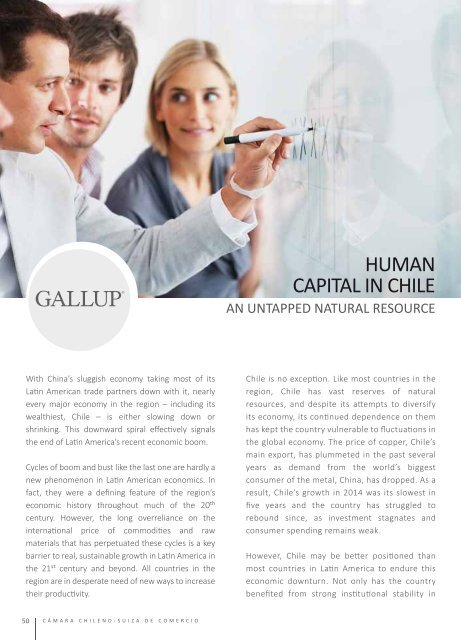OPORTUNIDADES Y NEGOCIOS CHILE - SUIZA
1LbZnc5
1LbZnc5
Create successful ePaper yourself
Turn your PDF publications into a flip-book with our unique Google optimized e-Paper software.
With China’s sluggish economy taking most of its<br />
Latin American trade partners down with it, nearly<br />
every major economy in the region – including its<br />
wealthiest, Chile – is either slowing down or<br />
shrinking. This downward spiral effectively signals<br />
the end of Latin America’s recent economic boom.<br />
Cycles of boom and bust like the last one are hardly a<br />
new phenomenon in Latin American economics. In<br />
fact, they were a defining feature of the region’s<br />
economic history throughout much of the 20th<br />
century. However, the long overreliance on the<br />
international price of commodities and raw<br />
materials that has perpetuated these cycles is a key<br />
barrier to real, sustainable growth in Latin America in<br />
the 21st century and beyond. All countries in the<br />
region are in desperate need of new ways to increase<br />
their productivity.<br />
HUMAN<br />
CAPITAL IN <strong>CHILE</strong><br />
AN UNTAPPED NATURAL RESOURCE<br />
Chile is no exception. Like most countries in the<br />
region, Chile has vast reserves of natural<br />
resources, and despite its attempts to diversify<br />
its economy, its continued dependence on them<br />
has kept the country vulnerable to fluctuations in<br />
the global economy. The price of copper, Chile’s<br />
main export, has plummeted in the past several<br />
years as demand from the world’s biggest<br />
consumer of the metal, China, has dropped. As a<br />
result, Chile’s growth in 2014 was its slowest in<br />
five years and the country has struggled to<br />
rebound since, as investment stagnates and<br />
consumer spending remains weak.<br />
However, Chile may be better positioned than<br />
most countries in Latin America to endure this<br />
economic downturn. Not only has the country<br />
benefited from strong institutional stability in<br />
recent decades, it has also forged important<br />
trade alliances with much of the world, and is<br />
arguably one of the region’s most open and<br />
investment-friendly economies.<br />
But some of Chile’s best opportunities to boost<br />
productivity may lie in accumulating human<br />
capital and maximizing the talent and skills of its<br />
existing workforce, which the Organisation for<br />
Economic Co-operation and Development (OECD)<br />
identifies as major obstacles to improving<br />
productivity at Chilean firms. In fact, the OECD<br />
advises that more systematic investment in the<br />
development of Chile’s human capital is<br />
definitely in order. In this regard, Chile has strong<br />
foundations that it can build from.<br />
Access to education in the country is already<br />
broader and better than average in Latin<br />
America, which is a decided plus as Chile seeks<br />
to improve its human capital. However, Chile’s<br />
education system still needs more investment.<br />
Chile’s workplaces continue to lack sufficient<br />
quantities of well-trained workers with higher<br />
education, which is exactly the type of advanced<br />
human capital that these businesses rely on for<br />
innovation and research and development.<br />
Chileans themselves likely see the need for such<br />
investment; Gallup surveys in 2014 showed that<br />
the majority (51%) of residents are dissatisfied<br />
with the educational system or the schools in<br />
their communities.<br />
Chile also stands to benefit from having one of<br />
the most engaged workforces in Latin America,<br />
according to Gallup’s studies of workers in the<br />
region and around the world. Based on people’s<br />
answers to questions that 30 years of Gallup<br />
research finds best predict employee and<br />
workgroup performance, Gallup categorizes<br />
workers as engaged, not engaged or actively<br />
disengaged. Nearly four in ten employed<br />
Chileans (39%) are engaged at work, easily<br />
outdistancing the regional average (29%).<br />
…some of Chile’s best<br />
opportunities to boost<br />
productivity may lie in<br />
accumulating human<br />
capital and maximizing<br />
the talent and skills of<br />
its existing workforce...<br />
Engaged Employees in Latin America and the<br />
Caribbean, by Country:<br />
Latin America & 29%<br />
the Caribbean<br />
Belize 42%<br />
Panama 41%<br />
Chile 39%<br />
Jamaica 36%<br />
Colombia 35%<br />
Costa Rica 35%<br />
Dominican Republic 35%<br />
Puerto Rico 35%<br />
Guatemala 34%<br />
Bolivia 29%<br />
Brazil 29%<br />
Mexico 29%<br />
Honduras 28%<br />
Ecuador 27%<br />
Uruguay 27%<br />
El Salvador 24%<br />
Argentina 23%<br />
Nicaragua 23%<br />
Peru 23%<br />
Venezuela 17%<br />
Paraguay 14%<br />
50 CÁMARA <strong>CHILE</strong>NO-<strong>SUIZA</strong> DE COMERCIO<br />
1 9 5 5 | Y E A R B O O K | 2 0 1 5 51


